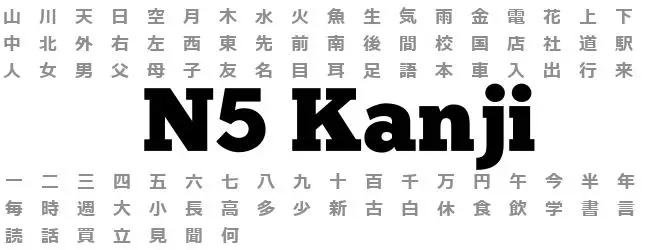When you first start studying Japanese, you are faced with a pretty big hurdle right at the start – you can’t read most of the language. That’s a pretty big problem because it closes off a huge pool of native materials which can be the best sources of learning materials, and the most natural.
Your brain isn’t even really set up for something like this (unless your native language is Chinese), so it is a bit hard to grasp at first. Instinctively, you want to be in control and there’s nothing more out of control than not even knowing how to read a language. So almost everyone starts with romaji, Roman letters, for the first few steps.
But it is important to start learning the native writing systems as early as possible. Ideally, it would be best if you tried to learn hiragana as soon as possible and then katakana. If you are still having a little trouble with hiragana, you might want to check out my Introduction to Japanese course.
Ok, you got that mastered, but now what? Now it is time to start learning kanji, the Chinese characters that Japanese has borrowed for its writing system. If you are unfamiliar with how Japanese writing became so, um, unique, you might want to read up on the history of Japanese kanji.
The N5 level contains around ~100 kanji that cover most of the basic vocabulary you’ll need when you are first starting. Unfortunately, at this level, you can’t make use of kanji radicals that much because a lot of the kanji are radicals themselves. You are going to have to learn them from scratch.
I try to think of these kanji in 6 major groups – nature, directions and locations, humans, numbers and time, adjectives and actions. I kind of cheat with a few of these to match a particular category, but for the most part, you can group them this way.
Nature Elements Kanji (17)
This includes everything from
山 川 天 日 空 月 木 水 火 魚 生 気 雨 金 電 花 土
Directions and Locations (20)
These can be a little bit more difficult to be honest. For example,
上 下 中 北 外 右 左 西 東 先 前 南 後 間 校 国 店 社 道 駅
Humans (15)
This is a bit of a stretch for some of these kanji, but I think you can group all the family kanji together with body parts and tools (like
人 女 男 父 母 子 友 名 目 耳 足 語 本 車 手
Numbers and Time (22)
The first few numbers are pretty easy (
一 二 三 四 五 六 七 八 九 十 百 千 万 円 午 今 半 年 毎 時 分 週
Adjectives (11)
No language would be complete without some adjectives to add color to what you are saying. The N5 kanji doesn’t give you too much to work with, but you have the basics, big and small, long but not short (短), old and new, and mysteriously, only the color white.
大 小 長 高 多 少 新 古 白 安
Actions (18)
The final category is actions, which again cover a lot of the basic actions you do on a daily basis – entering (a place), leaving (a place), eating, drinking, buying, coming, going, etc… I also think
入 出 行 来 休 食 飲 学 書 言 読 話 買 立 見 聞 何 会
A Good Start
As you can see, N5 kanji don’t exactly cover everything, but they can help you get around and understand a few simple things. One thing to note is that for the JLPT, these are the kanji that will probably appear on the test, and N5 vocabulary that contains non-N5 kanji will appear in kana. For example, 警官 (keikan, policeman) will be written as けいかん not in kanji, even though in native materials it would be written in kanji, 警官.












Thanks! This will help me a lot studying them!
np, I think it is important to try to break these up as much as you can. Hope it helps you out!
This is exactly the sort of concise and well-laid out post a student needs when they’re starting out with kanji!
Cheers!
hi i want to learn kanji for jlpt n5 level
i have a big doubt that what do i need to learn in the kanji ? the english meaning ? the hiragana reading ? the katakana reading ? the vocabluary ? i have visited many sites and they just provide with everything but donot tell what is to be learnt for N5 level.
please tell what all do i need to memorise while learning kanji for the exam
Have you started learning kanji with some kind of app? I think this might be the best way, or just study the N5 vocabulary with kanji instead of in kana.
A lot of people studying kanji individually with all the different pronunciations and meanings. This is useful, but not absolutely necessary and can get quite boring. How are you studying vocabulary now?
Really Thank you so much.
no problems!
Hi.. I have a huge doubt..
The jlpt n5 has 800 words in vocab. It has around 103 kanjis.
The memrise app for N5 has kanjis for all the words.
So my question is Do I have to learn all the 800 kanjis for the vocab words +103 kanjis ??
Or I need to learn 800 words(prounounciation +kana) and 103 kanjis??
because I am turning mad trying to remember all the kanjis for 800 words.
Kindly reply asap.
You only need to know the 103 kanji. On the test, they will use the words from the memrise list but they will be written in kana. The reason the Memrise deck uses all the kanji is because it is more useful that way. You can go out and start using and recognizes the words right away.
Hi,
Very useful post.I was struggling to remember the Kanjis….this segregation has helped me a lot.
Thanks
Hi, this is a great page, thanks! I was wondering what the priority should be for learning these Kanji, is it meaning, Onyomi the Kunyomi? Or is one more important to know for the level 5 exam? I want to learn all but not sure if it’s necessary in the time frame!
Thanks again,
Lily
i m going to appear the N5 exam. There is just a 10 days remaining for me. So please let me know only for the exam purpose how to read kanjis just to overcome the exam. Later on i will study throughly and that time i need a step by step kanji learning guide and materials to learn maximum kanjis till N4. Please guide me.
kanji is something you need to drill on a daily basis. There isn’t a lot you can do in the short term other than try to drill as much as you can before the exam. Don’t keep yourself up at night about it though.
Hi Mac, your website is one thing I’ve been following for a while and it does help in knowing that someone went through the same issues learning Kanji and then put it down in a really helpful manner so that it doesn’t look intimidating! I love your site! Based on a lot that I’ve read here and from the Internet, I think if I start now (Oct 2016) I should be able to give N5 (or maybe even N4) in July 2017 (I don’t think I’ll be well versed till Dec realistically looking at it). I a complete beginner to Kanji so can you please let me know if there’s some android app/site, or better still a book, which provides all N5 and N4 kanji, vocab etc. I don’t mind visiting different sites to get it from (say Kanji in one site and vocab in another). It would really help to consolidate what I need to study so that I can start studying it. One of the main challenges I face is this itself, vocab is still fine but kanji is all so spread out that finding one resource which’ll provide me that jlpt level by level and which will also provide me the readings and meanings is tough. I’ve already started by radicals (using a book for this) but I want to study smart as well so that I will be prepped for N4 (or at the least N5) by next year. Thanks for listening and hoping to hear back from you soon. Best regards, Merlyn
I’ve always recommended memrise.com for vocabulary. Try the readings course:
https://www.memrise.com/course/122927/jlpt-n5-readings/
hi are these kanji characters enough to n5 exam?????
Yeah, these are most likely to be on the test.
Im really an avid learner of japanese aiming for n5 but i thino the kanji book that im using have n4 too (which is good i guess and its hard to write than n5!) .
I am wondering if you have some good readings like some book good for n4-n5 kanji testing. I dont mind grammar though since im patient learning the language.
I don’t know which book you have now, but So-Matome is pretty good https://amzn.to/2Dw6XDz and there is a new Tuttle book that covers similar material https://amzn.to/2KYNgdJ
Your website is a reliable source for jlpt n5. Thank you Mac for sharing it to those who are eager to learn the language.
God bless you and your family